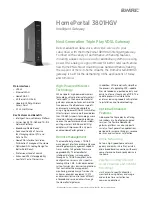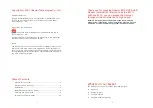
Glossary-5
Quadrature Phase Shift
Key (QPSK)
Modulation that sends two bits of information per symbol period with one bit
90 degrees out of phase with the other bit being sent. There are only four
constellation points. These points represent the four combinations that can take
place and are represented by the coordinates:
(0,0 - 0,1 - 1,0 - 1,1).
DQPSK modulation states that the information bits are differentially encoded
prior to being modulated.
quality of service
The accumulation of the cell loss, delay, and delay variation incurred by cells
belonging to a connection.
radio frequency (RF)
Signals that are used by a cable modem transmitter and receiver to send data
over the HFC network. A radio frequency carrier is modulated to encode the
digital data stream for transmission across the cable network.
return loss
A measurement of the quality of the match of the device to the cable system.
Return loss is the ratio of the amount of power reflected by the device.
RJ-45
An 8-pin modular connector on a Motorola cable modem or CMTS that
connects the modem to a PC or external hub. Used as a 10BaseT or 100BaseT
standard connector.
router
A device used to connect two subnetworks at the network layer. These
subnetworks may be similar. An internet protocol is used in each router and in
each host of the network. A router operates at Layer 3 of the OSI model.
service provider
A company providing cable data services to subscribers.
splitter
A piece of coax equipment that divides a single spectrum into multiple
identical spectrums.
TCP/IP
A set of protocols that provides the standards and rules for controlling and
managing communications between networks. TCP/IP has become the
worldwide standard for internetworking and is the basis for the worldwide
Internet. TCP/IP stands for Transmission Control Protocol/Internet Protocol.
There are related protocols, services, and applications that are part of the
TCP/IP protocol suite.
TCP/IP Communications
Stack
Software in the subscriber PC that processes packets through the
communication layers. The TCP/IP communication stack handles the
communications between the subscriber’s application, for example, an Internet
browser, and servers on the Internet.
Transmission Control
Protocol (TCP)
A reliable transport protocol of the Internet suite. TCP is a connection-oriented
protocol that uses IP to transmit the data across the network. TCP is an
end-to-end protocol defining the rules and procedures for exchanging
information between communicating partners (hosts). Transmission Control
Protocol resides in the Transport Layer of the OSI stack. It works on top of
connectionless Network Layer IP. TCP segments messages into datagrams,
uses a timer to keep track of outstanding datagrams, retransmits datagrams if
requested, and performs error checking on incoming datagrams.
Universal Serial Bus
(USB)
A device that allows PCs to connect to peripherals, eliminating the need for an
Ethernet Card.
Summary of Contents for AL 200
Page 1: ...3UHOLPLQDU Motorola AL 200 Multi User Modem Installation Manual ...
Page 4: ......
Page 8: ......
Page 10: ...x Contents continued ...
Page 13: ...The Motorola AL 200 Multi User Modem 1 3 About the Motorola AL 200 Multi User Modem ...
Page 24: ...1 14 The Motorola AL 200 Multi User Modem Training the Subscriber to Use the AL 200 ...
Page 28: ......
Page 36: ......
Page 38: ...D 2 Regulatory Information ...





































